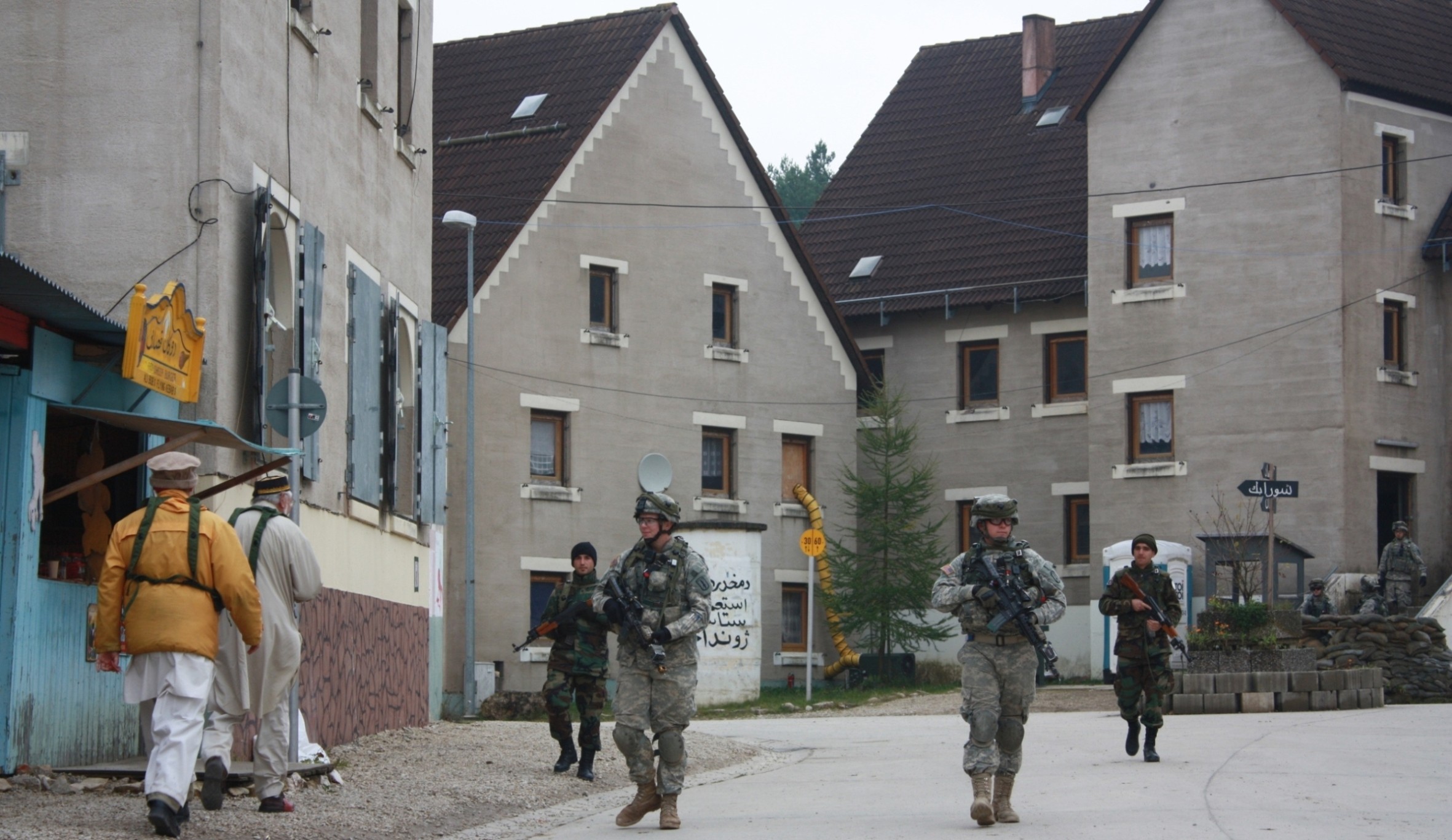HOHENFELS, Germany (Army News Service, Nov. 8, 2010) -- Troops from eight coalition nations joined Soldiers from the 170th Infantry Brigade Combat Team recently to train them for an upcoming deployment to Afghanistan.
More than 4,000 participants from all four U.S. military services and eight coalition partners took part in the mission rehearsal exercise for the 170th IBCT at the Joint Multinational Readiness Center.
Troops from Albania, Belgium, the Czech Republic, France, Germany, Poland, Romania, and Slovenia participated in this three-week-long exercise with the IBCT from Baumholder, Germany.
The training also included support from the U.S. Air Force Europe Warrior Preparation Center, known as the "Bullseye Team," and U.S. Joint Forces Command's Joint Fires Integration and Interoperability Team, known as JFIIT.
"The work done by JFIIT, USJFCOM and USAFE provided us additional capabilities and allowed us to do things like (provide) continuous virtual unmanned aircraft systems and close air support, even if we didn't have those assets flying live here," said Army Col. John Spiszer, commander, JMRC. "That's a significant advantage for the units training here, and when you integrate the multinational forces into the mix, it's a real good situation and separates us from the other training centers."
"The JMRC, USAFE, and USJFCOM team are great examples of how we can integrate our coalition partners into a first-class training environment that benefits the entire team," said Marine Corps Maj. Kevin Moody, JFIIT's JMRC lead. "This training will help the entire fires team shorten their learning curve and will improve the integration of coalition assets so the ground commander can more efficiently leverage all available capabilities in Afghanistan."
The exercise integrated a variety of joint enablers to replicate the resources that the IBCT commander will have to support the International Security Assistance Force, or ISAF, in Afghanistan.
"The stated mission of the Taliban is to defeat NATO and kick NATO out of Afghanistan," said Army Brig. Gen. Steven Salazar, commander, Joint Multinational Training Command, Grafenwoehr, Germany. "What we're doing is NATO training by preparing our units, as well as our coalition partners, for NATO operations in Afghanistan. No other combat training center is doing that."
JFIIT helped integrate several joint intelligence, surveillance, and reconnaissance assets to facilitate the joint fires targeting process.
"Without the support from JFIIT, we couldn't do our mission of integrating CAS training for USAFE into the Army's MRE at JMRC," said Air Force Lt. Col. Scotty Briscoe, commander, Detachment 2, Warrior Preparation Center in Hohenfels.
"These joint assets help round us out and provide crucial resources that we couldn't otherwise provide to the training audience," said Army Maj. Sherman Watson, plans chief, JMRC. "Our goal is to replicate the operational environment."
Providing a realistic and challenging multinational training environment is just one of the unique advantages to training at JMRC, according to participants at the exercise.
"The training here has been spot on," said Army Chief Warrant Officer Philip White, Apache attack helicopter pilot from 3-159 Attack Reconnaissance Battalion, Ansbach, Germany. "The opportunity to train at a world-class facility with so many joint and coalition partners has been incredible. I think we're all learning a lot of valuable lessons from each other and that will make us a better team when we deploy."
"I've been impressed with many of our multinational partners that are here training with us, especially the German joint fires observers," said White. "They're as good as I've seen and I think we mesh our skills together quite well."
"Our ability to integrate JISR assets into our targeting process has been superb," said Army Capt. Jamen Miller, intelligence officer, 2-18 Infantry Battalion, 170th IBCT. "This is the first time that many of us have had the opportunity to work with many of these enablers that we'll see once we're deployed. This training will absolutely benefit the entire unit."
"The training at JMRC has been very useful," said Polish Special Forces Warrant Officer C. Charles, joint terminal attack controller. "The familiarization training that we receive by working with many of our key partners is valuable and will be important to the speed in which we can successfully integrate together once we're in Afghanistan."
Enhancing air-ground integration and CAS skills of both U.S. and multinational participants were some of the benefits of the exercise.
"The training here is about combined fires, not just joint fires," added Moody. "The unique nature of this training center is that it provides exceptional air-to-ground training for the entire joint and multinational team that accurately replicates what is occurring in theater."
According to senior leaders, the ability to forge important relationships with both joint and multinational partners is a strength that the command will build on to enhance training at JMRC for the foreseeable future.
"We work with virtually all the partner contributing nations in Europe and stretching into Central Asia, Georgia, and a lot of the Eastern European countries, like Romania, Poland, the Czech Republic, and Slovenia," Spiszer added.
"We've got a great joint and multinational team that encompasses so many important enablers," he said. "Together, we create a more realistic training environment which translates into greater success downrange where it matters most."


Social Sharing